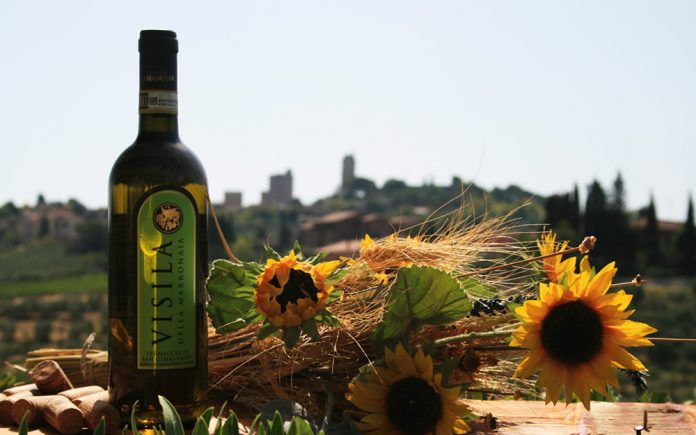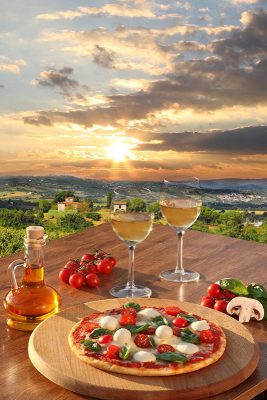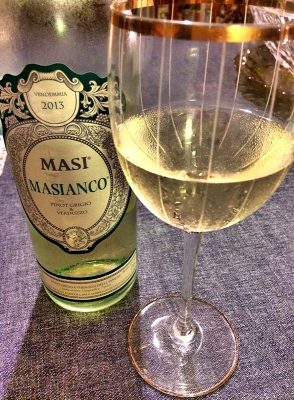
By Rick Riozza
Last week we reminisced on a trio of European wines that would likely be on the bucket list of any vino enthusiast. On the other side of vino ventures, there are so many fun and interesting wines around the world, it’s simply a thrill to get to taste and enjoy as many as we casually can.
It’s the summertime and every white wine in town is fair game for us columnists to enlist the interest of our readers. In our hot valley, we’ve been traditionally and continually sucking up all the Sauvignon Blanc we can. And, as I’ve noticed in the past five years or so, the thirst-quenching Italian Pinot Grigio has also been selling at record numbers.
Indeed—last year, the vast appellation of Delle Venezie DOC, that spans over 60,000 acres of vineyards in northeast Italy showed a 34% increase in sales of Pinot Grigio totaling 223 million bottles!
Sorry to report, but personally, I’ve never been a big Pinot Grige fan. I’ve found the wine to be too light—surely refreshing of course, but just not enough oomf for me to desire the wine over other more complex white wines.
But hey!—didn’t I just write a CV Weekly column titled “Love Story in the Time of Coronavirus”, wherein I heartily recommended the Love Story Pinot Grigio from Verona? Yes, I did and of course there is always some very good stuff out there that is clean, fresh, aromatic with enough nuance to be interesting and delicious.
As one can discern by the title of this piece, however, our column will venture out to other vino venues of particular interest in the wine country of Italy. Many wine lovers these days are well aware of all the different red wines Italy offers. Ditto that for white wines as well. Unfortunately, because of the vast amount of vini bianchi, we’re restrained by space, to highlight only a few that are easily obtainable here in the states.
Starting with the northwest part of Italy known as the Piemonte wine region, the two local varieties that pleasantly come to mind are the Cortese grape that produces the wine with the fun pronunciation of Gavi di Gavi; and the Arneis [ahr-NAYSS] grape producing the little more difficult to say, Roero [ROY-eh-thoe] DOC.
Both mouthwatering wines are light to medium-bodied, dry not sweet, with citrusy acidity around orchard fruit and mineral flavors. The Arneis is the richer of the two focusing on almonds, apples and pears; the Gavi wines are lighter with a bit more acidity of lemon and lime with minerality.
 If you’re planning to serve some savory summer platters of antipasto, cheeses, pasta salads, pizza, risotto, seafood, shellfish, veal, or vegetables, look to the Gavi and Roero. Gavi producers include Bergaglio, Broglia, Chianlo, La Giustiniana, La Scola, and Villa Spraina. For Roero DOC look for Vietti, Bruno Giacosa and Ceretto.
If you’re planning to serve some savory summer platters of antipasto, cheeses, pasta salads, pizza, risotto, seafood, shellfish, veal, or vegetables, look to the Gavi and Roero. Gavi producers include Bergaglio, Broglia, Chianlo, La Giustiniana, La Scola, and Villa Spraina. For Roero DOC look for Vietti, Bruno Giacosa and Ceretto.
When we stayed in the Tuscany town of Radda, while lunching, we enjoyed the two wonderful white wines which often get mixed up simply by their names: Vermentino and Vernaccia.
Vermentino is an Italian western coast & Sardinian wine that is dry, medium-bodied, with high acidity but aromatic and fruity. It’s probably the sexiest choice to serve with lobster and will also be a good match for summer pesto & pastas. Flavors include almonds, green apples, citrus, fennel, flowers, herbs, lemon, minerals, nuts, and tropical fruits. Sometimes you’ll even get a whisper of spritz in the beverage.
The lovely full name of Vernaccia di San Gimignano [ver-NAH-chyah dee sahn jee-mee-NYAH-noh] matches the beautiful ancient skyline and announces the aromatic dry medium-bodied white wine of Tuscany. Most of it is un-oaked and rather crisp; the acidity is medium to high, with similarities to a Macon Chardonnay but with brighter notes of apples, citrus peel, earth, flowers, ginger, herbs, lemons, nuts, tropical fruits, vanilla with a touch of bitter almond finish.
One of our best memories of dining in Italy last year was—of course, experiencing the pizza of Napoli. Pizza Napoletana, originated in Naples way back when tomatoes where brought to Europe in the 16th century from Peru. This style of pizza is prepared with simple and fresh ingredients: a basic dough, raw tomatoes, fresh mozzarella cheese, fresh basil, and olive oil. One of its defining characteristics is that there is often more sauce than cheese. No fancy toppings are allowed!
And generally, the white wine served with Neapolitan pizza—especially during the warm day, is the chilled Falanghina [fah-lahn-GHEE-nah]. The other two white wines you’ll also see on the table is the famed Fiano and the Greco di Tufo. These are the wines of the southern Italian region of Campania—that include Naples, Pompeii and the romantic Amalfi Coast.
Falanghina is fun and an easy going quaff: light-bodied but with a fleshy palate of apricot, peach, pine, jasmine, pears, minerals and smoke (the tie-in to the pizza that’s been in a 900+ degree oven for a couple of minutes). Fiano is the region’s top-quality varietal that is richer than the Falanghina that accentuates hazelnuts in the flavor. The Greco is somewhat in between the two. Bevi e divertiti!!
 While I’ve been writing piece, I’ve also been sipping on—wait for it: a Pinot Grigio!—go figure. Anyway—I am heartily recommending this 2018 Masi Masianco Pinot Grigio Delle Venezie. Masi calls this wine the estate’s white “Supervenetian,” a wine of great personality.
While I’ve been writing piece, I’ve also been sipping on—wait for it: a Pinot Grigio!—go figure. Anyway—I am heartily recommending this 2018 Masi Masianco Pinot Grigio Delle Venezie. Masi calls this wine the estate’s white “Supervenetian,” a wine of great personality.
And a great personality it has!! It reminds me of a zesty New Zealand Sauvignon blanc without all the grass and cat pee. Masianco blends Pinot Grigio, cultivated in Friuli, with native Verduzzo grape, picked slightly over-ripe and mature. It’s a great pinot grige blend with bright and clean white fruit flavors, and, quite energetic in the buzz it provides! One can say it’s got some oomf to it!
A treat and a tasty buy at around $14 or less. Saluti!










































